Introduction |
Formats |
Printings |
Dies |
Paper |
Straight Edges |
Coils |
Fakes |
Forgeries |
Terminology |
Varieties |
Cancellations |
Rates |
Bibliography
Cancellations on the Admirals
During the 17 or so years the Admirals were in use, many different cancellations were used on Canada's mail. Older cancelling devices first used in the 19th century - the squared circle, for example - were phased out and new types introduced. While cancellations are properly collected on cover or document, the collector of the Admiral stamps can also put together an interesting collection of cancels on single stamps.
This page shows some of the cancellations found on the Admirals. Hans Reiche's handbook, Admiral Cancels, mentions many of these cancels. Some cancels shown here are not in his book, and some shown in his book are not shown here, so neither is a complete listing.
Postal cancellations are shown first, then fiscal cancellations. The postal cancellations are listed in alphabetical order by type of cancel.
1. Postal Cancellations
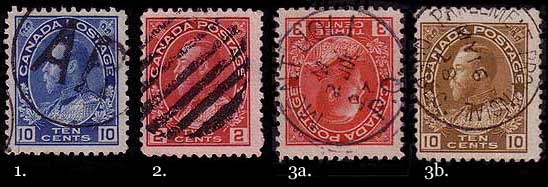
-
Acknowledgment of Receipt. This cancel is rarely found on stamps.
-
Bars. Cancellations consisting of bars are often part of
another cancellation such as the duplex cancel (see below). However,
some bar cancels are stand-alone cancels, not part of another
type.
-
Circular Date Cancels (CDC). CDC cancels show the city /
town name, province, and date of mailing. The circle comes in
several diameters. Of special interest are CDCs from post
offices established for government institutions such as the PARLEMENT
PROVINCIAL QUEBEC cancel (3b above). Circular date cancels can
be part of a duplex cancellation (see below).
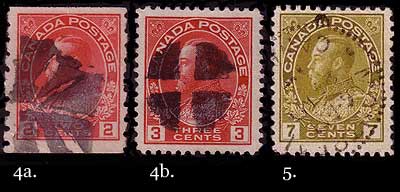
-
"Cork" Cancels. The cancelling device was usually made of
cork or brass. These were more popular in the 19th century, and are not
common on the Admirals.
-
Dotted Circle. The seven examples I have are from Montreal.
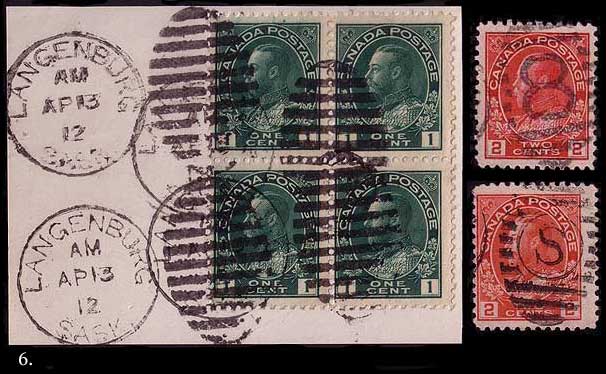
-
Duplex Cancels. Duplex cancels consist of a circular date
cancel and a group of bars produced by the one cancelling device.
There are several different styles, and sometimes letters,
numerals, and words are found in the bars. From the
Admiral period, the best known are probably the Montreal duplex
cancels with the letters A to J and the numerals 1 to 13. However,
several other cities used duplex cancels with letters in the bars (such
as the example above with the S on the 2¢ carmine) during the
Admiral period. All these variations combine to make duplex cancels a
specialized field in itself.
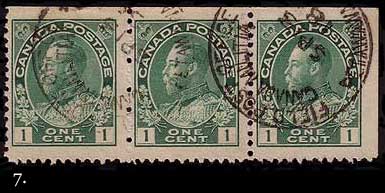
-
Field Post Office Cancels. These originate from post offices
established for servicemen on active duty.
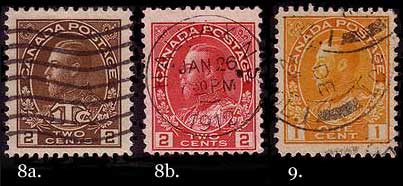
-
Machine Cancels. The "wavy lines" of the International Rapid
Machine cancels are probably the most common cancel found on the
Admirals. Even these can be of some interest because various numbers
and letters are sometimes found between the lines. The circle part of
the cancellation can be identified by its diameter (about 21 mm) and the
complete year at the bottom. Slogan / pictorial cancels (see below)
are also machine cancels.
-
Paquebot Cancels. Letters mailed onboard ship received
paquebot cancels. At the next port of call, they were delivered to a
post office where they entered the mail system.
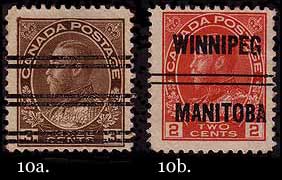
-
Precancelled Stamps. Precancelled Admiral stamps come in
two flavours: bar precancels (10a above) and town and city precancels
(10b above). Bar precancels exist on the following sheet stamps:
| 1¢ yellow, Dies I and II | 5¢ violet |
| 2¢ green | 7¢ bistre |
| 3¢ brown | 10¢ blue |
| 3¢ carmine, Dies I and II | 10¢ bistre brown |
| 4¢ bistre | 20¢ olive green |
The 1¢ yellow sidewise coil, Dies I and II, also exists with a bar precancel.
There are 51 town and city precancels on the Admirals. Many town and city precancels come in different styles. For example, there are ten different ones for Toronto on Admiral stamps. Many precancels also exist inverted, and a few come with the overprint doubled.
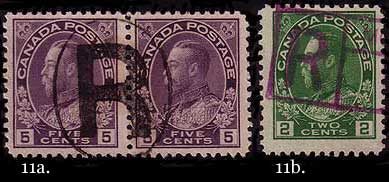
-
Registered Cancels. There are several different types of
registered cancellations, but the most common is the large R in an oval.
Registered cancellations also come in different sizes and
colours. The example of the R in an oval (11a above) is a fairly
small example of this cancellation; they usually are much larger.
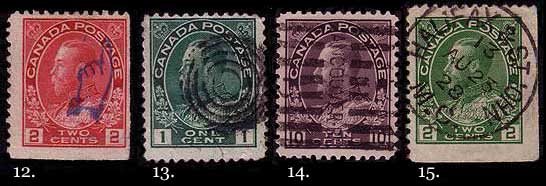
-
Return to Sender Hand. I suspect this is not a genuine postal
marking. The hand seems a bit small in
comparison to those found on covers of the Admiral era.
-
Rings. Cancels with various numbers of rings exist. Ring
cancels were used more in the 19th century, and are not often seen on the
Admirals.
-
Roller Cancel. Not popular with stamp collectors because they
do such a good job of obliterating the stamp, roller cancels were
nonetheless used extensively during the Admiral period. Several
different styles exist. Nice clean, clear examples are hard to find.
-
RPO (Railroad Post Office) Cancel. The Admiral era coincides
with the heyday of railroad post offices. Probably several hundred RPO
cancels can be found on the Admirals.
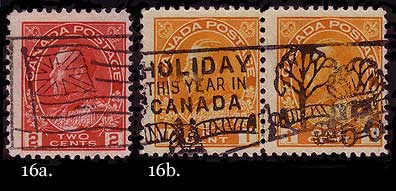
-
Slogan / Pictorial Cancels. There are hundreds of these
cancels, many of them with one version in English and another in French.
They promote everything from the War effort to tourism (16b
above). They publicize Post Office directives and services as well as
advertise various events and anniversaries. These are usually a type
of machine cancel, and could be listed as such.
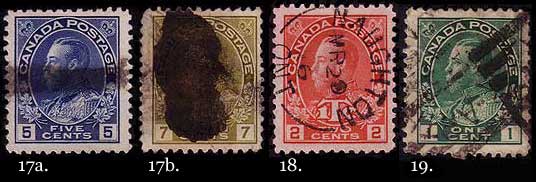
-
Smears and Smudges. The two examples shown above (17a and 17b)
are quite representative of this type of cancellation.
-
Split Ring Cancel. This cancel was first used near the
beginning of the Small Queens era or before. By the time the Admirals
were in use, most larger towns and cities had moved on to other types of
canceling devices, but the split ring cancel continued to be used in
many small towns.
-
Squared Circle. The squared circle cancellation was
introduced in the early 1890s, but by the Admiral era, it was rarely
used. The example shown is from Port Arthur, ON.
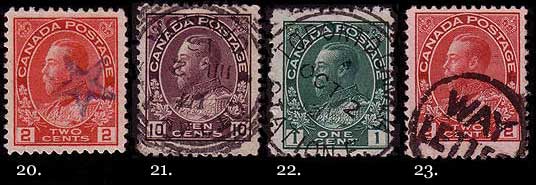
-
Star. I suspect this cancellation is not a genuine postal
cancellation.
-
Three-Ring Cancel. This cancel comes with at least two
diameters. Ottawa is the most common, but other cities also exist.
-
Two-Ring Cancel.
-
Way Letter.
2. Fiscal Cancellations
The "Special War Revenue Act" passed by the Federal Government in 1915 imposed a 1¢ War Tax on letters and postcards effective 15 April 1915. The Post Office issued War Tax stamps for the payment of this tax.
The Act also imposed a tax on cheques, promissory notes, and money orders. Although revenue stamps were issued for the payment of this tax, postage stamps were regularly used for this purpose. The stamps were affixed to a financial instrument such as a cheque and cancelled by a financial institution.
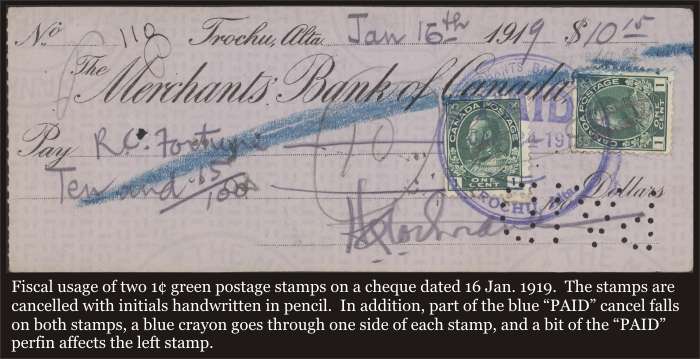
A wide variety of fiscal cancellations exist, often in bright colours. Fiscal cancels can be divided into two groups: those that are manuscript (done by hand with pen, pencil, or crayon) and those that are handstamped with a cancelling device. What follows is just a small sample of the types of fiscal cancels found on the Admirals.
2.1 Manuscript Fiscal Cancellations
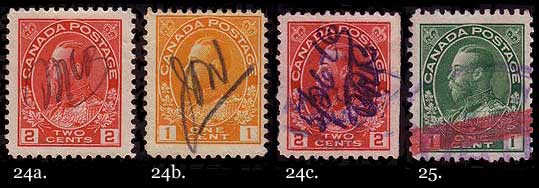
-
Initials, Names, and/or Dates.
-
Crayon. Cheques were often cancelled with a heavy line made by a
crayon. This often ended up on the stamp(s) affixed to the cheque.
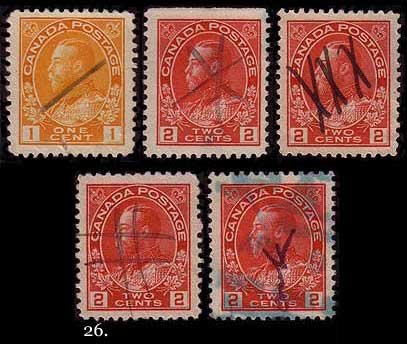
-
Miscellaneous signs, symbols, etc. Included here are strokes of a
pen or pencil, asterisk, Xs, and "pound sign." Many others can be
found.
2.2 Handstamped Fiscal Cancellations
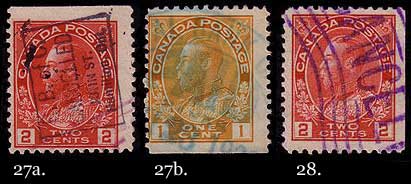
- Bank Cancels. There are two types: small usually rectangular
cancels (27a above) or large cancels often containing the word
PAID (27b above). Both types of cancels have the name of the bank
in them.
-
CANCELLED. The word CANCELLED is usually too large to fit
completely on one stamp.
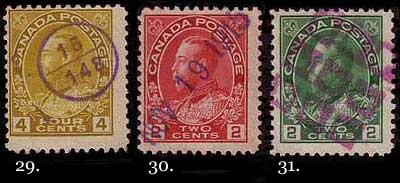
-
Small Circle or Triangle Cancel. Has numbers and/or
letters inside.
-
Straight-line Date Cancel.
- "Multiple Squares". For lack of a better term.
Introduction |
Formats |
Printings |
Dies |
Paper |
Straight Edges |
Coils |
Fakes |
Forgeries |
Terminology |
Varieties |
Cancellations |
Rates |
Bibliography